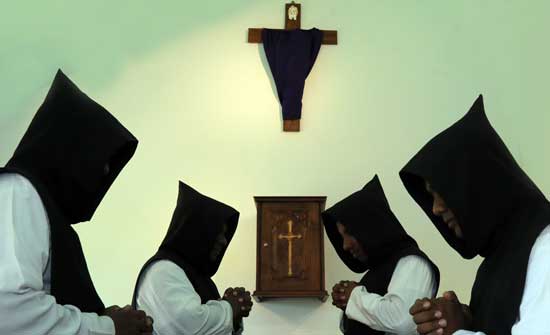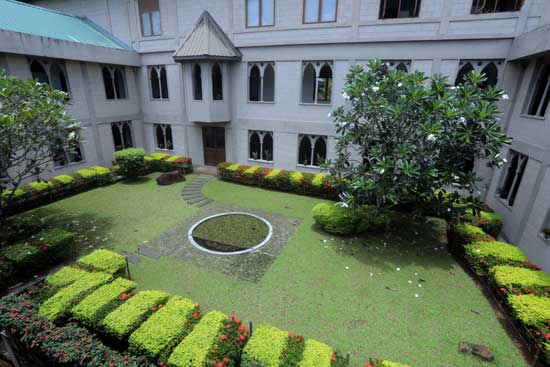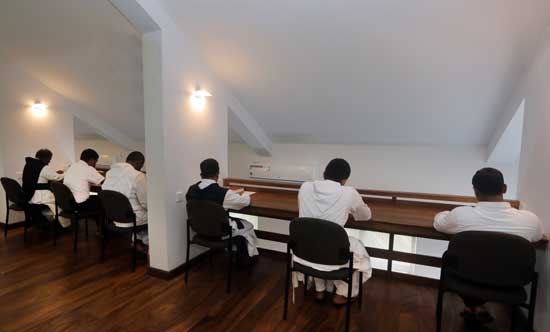A life of prayer and silence
Far, far away from Golgotha (‘Place of the Skull’) or Calvary just outside the city walls of Jerusalem, the scene of the crucifixion and resurrection, nestling atop a small hill in
Sri Lanka’s rural hinterland of Halkandawila, is an oasis of peace and tranquillity.

Hooded monks in prayer: Warding off distractions. Pix by M.A. Pushpa Kumara
Around 7km from the turn-off known as the Podi Rail Gettuwa on Galle Road, Payagala, a miniscule group of monks of the Catholic Church, are walking in the simple and humble footsteps of their Master whose teachings changed the course of world history around 2,025 years ago.
For us, it was stepping back in time nearly 1,000 years at ‘Stella Maris’ (Star of the Sea) when we accessed this austere monastery of the Cistercians set amidst lush greenery, past a large wooden cross draped with a purple shawl and adorned with the symbol of ultimate suffering, the crown of thorns.
Frenetic earthly activity paled and time stood still as we were greeted at the door by Superior Fr. Benedict Jayamanna, the contrast from the rat race being obvious – not just in what they wear but also in their lifestyle.
“This monastery is consecrated to Mother Mary (the mother of Christ),” says Fr. Benedict as he explains that for them it is a life of prayer, “searching for God in prayer and silence”.
When we take up the offer of refreshing cups of tea, he whispers to another, the monastery devoid of loud speech or heavy footfalls, except external birdcalls and sometimes the barking of a dog filtering through, and of course, my voice which I soon learn to mute.

Fruit of their labour: Well manicured garden
As we spend the morning with the monks concluding with prayers at noon chanted in the austere chapel, followed by a delicious vegetarian lunch as it is Lent, we see that their lives revolve around three pillars essential to moulding a holistic person.
“Ora et labora et lege” (“Pray, work and read”), is the order of their day, guiding them towards obedience and conversion of manners and stability.
For the three priests – Fr. Benedict, Fr. Bernard Inbarajan & Fr. Sylvester Perera; the four ‘professed’ Brothers awaiting their final vows and priesthood; the two Novices training for the priesthood; and the two Candidates who wish to find out whether this is their calling, there is a strict daily routine.
The attire of the priests (professed monks) too is in contrast to other orders of the Catholic Church. Traditionally in a white habit, which has brought on the name of ‘White Monks’, there is a black scapular (apron) or cloak over it and Fr. Benedict says that they pull on the hood when praying and reading, denoting the warding off of distraction. The Brothers are in white habits and the Novices in black trousers and white shirts.
The day at the monastery starts at 5.30 a.m. with a structured balance of prayer, manual labour and quiet reflection, with seven breaks for liturgical prayer and periods of silence.
“This is to foster a deeper connection with God,” says Fr. Benedict, explaining that ‘Vigils/Matins’ is when they gather for the first prayer service of the day, with attendance of ‘Lauds’, another prayer service and mass, followed by breakfast and a period of silence.
Throughout the day, they interrupt their schedule to gather in the chapel for these seven times of liturgical prayer, known as the Divine Office (Work of God) including services like Terce, Sext and None which correspond to the 3rd, 6th and 9th hours of the day.
Labour is also very much a part of the routine, with all housework such as cooking and cleaning being handled by them, while the manicured quadrangle and front area with splashes of colour from ixora and araliya dotted with ponds full of fish and the lush coconut and tea land around it are testament to the manual work in the sprawling gardens.
“We maintain an atmosphere of silence, both during work and prayer, while there are short periods of recreation allowing for interaction with fellow monks. Then there is Study and Lectio Divina, which is time dedicated to the contemplative reading of scripture,” says Fr. Benedict.
Looking at the evening hours, he talks of how they gather for Vespers, a major prayer service, followed by dinner; then a community meeting to discuss matters of concern; Compline: the final prayer service of the day, after which the monks retire for the night and to their ‘grand silence’. There is also Eucharistic adoration where they pray and meditate in the ‘real’ presence of Christ displayed in the monstrance and recitation of the rosary in honour of Mother Mary.

Time for contemplative reading
Deeply dissatisfied over the laxity in the observance of the Rule of St Benedict – a strict and structured monastic life – it was in 1098 that a group of Benedictine monks, led by St. Robert of Molesme, joined by St. Alberic of Cîteaux and St. Stephen Harding set up the Cistercian Order in the village of Cîteaux near Dijon, France.
Getting its name from Cistercium, the Roman name for Cîteaux, this order’s monasteries are grouped into ‘Cistercians of the Common Observance’ (O. Cist) which is a more moderate approach to monastic life and ‘Cistercians of the Strict Observance’ (Trappists – O.C.S.O).
Cistercian monasteries including Stella Maris whose architecture is characterised by their simplicity, austerity and utilitarian design are built with plain, natural-coloured stone. Portraying the emphasis on a life of prayer and contemplation, they are sans elaborate ornamentation or decoration. While those in France and the United Kingdom have been cited as “fine” examples of Romanesque and Gothic architecture, the abbeys of Fontenay in France and the ruins of the Fountains abbey in England and the monasteries of Alcobaça in Portugal; Poblet in Spain; and Maulbronn in Germany; are today UNESCO World Heritage Sites.
In Sri Lanka, it had been in August 1845 that two Cistercian monks had begun their work, with the more permanent Stella Maris Monastery being established recently after a nomadic existence, under the inspiration of Malcolm Cardinal Ranjith and Austria’s Rt. Rev. Dr. Florian Kuntner.
Now sharing their spirituality, the monks of Stella Maris have opened their doors to retreats, guidance and counselling, as they also move among the flock to gently guide teenagers and youth.
For anyone wishing to get re-energised, develop inner strength and gain solace from worldly stresses, Stella Maris beckons with warmth and understanding.
(Please call: 076-3372535
for more information)
Searching for an ideal partner? Find your soul mate on Hitad.lk, Sri Lanka's favourite marriage proposals page. With Hitad.lk matrimonial advertisements you have access to thousands of ads from potential suitors who are looking for someone just like you.


